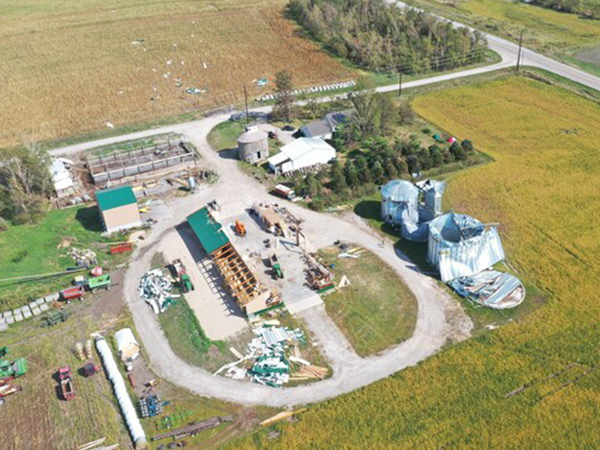Reinforcing Rural Infrastructure Against Extreme Weather
By Jackie Ostrowicki
April 2021
The storage bins and silos dotting the rural landscape often hold thousands of bushels of grain or hundreds of tons of livestock feed. When those structures are damaged or destroyed, the impact is felt locally—but can also disrupt the U.S. economy and global food production.
Christine Wittich, an assistant professor of civil and environmental engineering at UNL, is studying how to improve these infrastructures—making them less susceptible to significant winds and reducing the impact of storm damage to rural communities.
Wittich, who grew up in Staten Island, N.Y., was a teen when she lived through 9/11. "It was really profound to see such monumental structures—a part of the fabric of my city, my skyline—and to see the huge amount of devastation. It really got me interested in what we can do to make our structures—the places where we reside, the places where we work—stronger to be able to withstand these types of threats."
She studied civil engineering at Lafayette College in Pennsylvania, where she began observing more and more natural disasters like hurricanes and earthquakes. Wittich realized there was a lot of work that could be done in this area. "People want to feel protected in their homes, to safely go to school and work," she said. "I became really passionate about structural engineering for natural hazards."
A Focus on Rural Structures
After graduation, Wittich went to the University of California in San Diego, where she received her master's degree and Ph.D. in structural engineering, becoming an expert in earthquake engineering and making structures earthquake resistant. After moving to Nebraska, she started noticing the very significant wind hazards that occur, such as tornadoes and high wind storms.

She began to focus on the specific structures unique to the state. "Nebraska has a critical agricultural economy that's supported by structures that help sustain that economy. One of those structures are steel grain bins. Every time there was a tornado or high wind event, I would drive around in my car to make some observations about structural performance," Wittich said.
"I started seeing a lot of failures associated with steel grain bins, even after fairly moderate events. This became a real opportunity to figure out what exactly is going wrong. What's the root cause of these issues? And what can we do to make it better?"
There are over 750,000 silos in the U.S.—and the structures themselves are not inexpensive. The capital cost of installing a 10,000-bushel capacity grain bin is around $32,000 and a 20,000-bushel capacity bin costs approximately $48,000. The grain they contain also can be measured in dollars and cents. With recent wheat prices at six dollars a bushel, when a grain bin is damaged, losses can range up to six figures. And even if the structure was insured, replacement structures don't always arrive in time to salvage the grain.
Improving Silo Design
On August 10-11, 2020, a derecho swept across the Plains—a severe wind storm that produced widespread high, straight-line winds; extreme, torrential rain and hail; and an outbreak of weak tornadoes. The storm killed at least four and left behind significant damage in agricultural areas along a 750-mile path. In fact, its estimated $7.5 billion toll made it the most damaging thunderstorm event in American history.
Wittich obtained a one-year, $45,000 grant from the National Science Foundation to focus on the derecho's aftermath. Her findings have the potential to influence standards for new construction and lead to solutions that safeguard existing structures. Until engineers better understand these fundamental research questions, agricultural and rural communities will continue to be devastated by high-wind events, Wittich said.
"Right now, as a structural engineer, I'm focused on the structure itself. But there's also solutions to disaster mitigation that are not at the structural level. Structural failure ultimately impacts people."
–Christine Wittich
"Right now, as a structural engineer, I'm focused on the structure itself," said Wittich. "I talk with people about the impact that this has on their business in order to understand the problem. But there's also solutions to disaster mitigation that are not at the structural level. Structural failure ultimately impacts people."
She believes it's important to look at natural hazards holistically, taking an interdisciplinary approach with many different experts, such as engineers, agricultural economists and sociologists. "We have to examine the problem from a bigger perspective," Wittich said. "That's how we will make the best recommendations moving forward—and that's how we will enable a sustainable, resilient agricultural economy in the Midwest."
Discover our Podcast Series
The “Leading Nebraska” podcast shares the stories of the researchers, students, teachers and others across the University of Nebraska's four campuses who are making an impact. From teachers and doctors to engineers and ag experts, these Nebraska leaders are touching lives and making a difference.